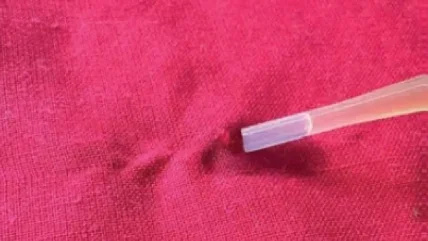
Pulled threads and yarn slippage are a nightmare, so let’s look at what can be done to rectify what is in fact a problem that most cleaners will be familiar with and which can, at worst, lead to compensation claims. Yarn slippage is the shifting or slipping of yarns in woven fabrics and is often brought about by stress or even abrasion during wear. Some closely woven textile types such as taffeta can be prone to yarn slippage in drycleaning, this is most likely to occur when cleaned in perchloroethylene solvent due to it’s very high specific gravity and increased mechanical action within the machine.
When yarn slippage occurs in these fabrics it is usually caused by excessive mechanical action during the cleaning cycle. However, perhaps the most common cause of damage and yarn slippage is inappropriate use of the steam or air gun but it can also happen through excessive tension along seam areas when a garment is a very tight fit; there is little the cleaner can do to rectify this and of course, if it develops or is exacerbated by cleaning, provided an appropriate process cycle has been used, the cleaner is not responsible.
While minor faults can usually be quickly corrected by gentle manipulation, a light mineral oil such as cycle oil is often essential when attempting to rectify the more serious faults and the chances of complete success depend very much on the extent of the damage and whether yarns are intact or have been severed.
Pulled threads and snags
In cases where a yarn has been pulled out and has formed a loop, apply light oil along the line of the pulled thread and to the looped yarn. The function of the oil is to lubricate the yarn to allow it to slide easily back into into place within the woven fabric. After applying the oil, starting at a point where any puckering or distortion resulting from the pulled thread can be seen, and using the thumbs and forefingers, apply tension at several points along the thread line and gradually draw the loop into its normal position in the fabric. Finally dryclean the item to remove the oil.
Yarn slippage
As cleaners will, I am sure, be well aware, the steam gun and the air gun have the potential to cause major fabric damage particularly on delicate and fragile textiles. If a hole has been blown in fabric the only solution will be a neat repair or an in weave but in the case of delicate fabrics, compensation will be the order of the day.
The correction of yarn slippage is similiar to that of pulled threads but in most cases is often a little more difficult and time consuming. Start by applying the light oil to the whole of the affected area then, once again using the thumbs and forefingers apply gentle manipulation around the area of displaced yarns and gradually try to work them back into their normal position within the fabric and then re-clean the item. It is often the case that while you may produce a major improvement, the result may be less than perfect, however the mechanical action during drycleaning to remove the oil will usually complete the job and completely restore the damage, if not repeat the procedure.
Wetcleaners
In the case of both pulled threads and yarn slippage, where items have been processed through a wetcleaning system, a dryside kit spotter such as paint or grease remover should be applied to the oiled areas followed by a re-clean. Do not apply any form of mechanical action (such as tamping or working with the spatula) prior to re-cleaning.






